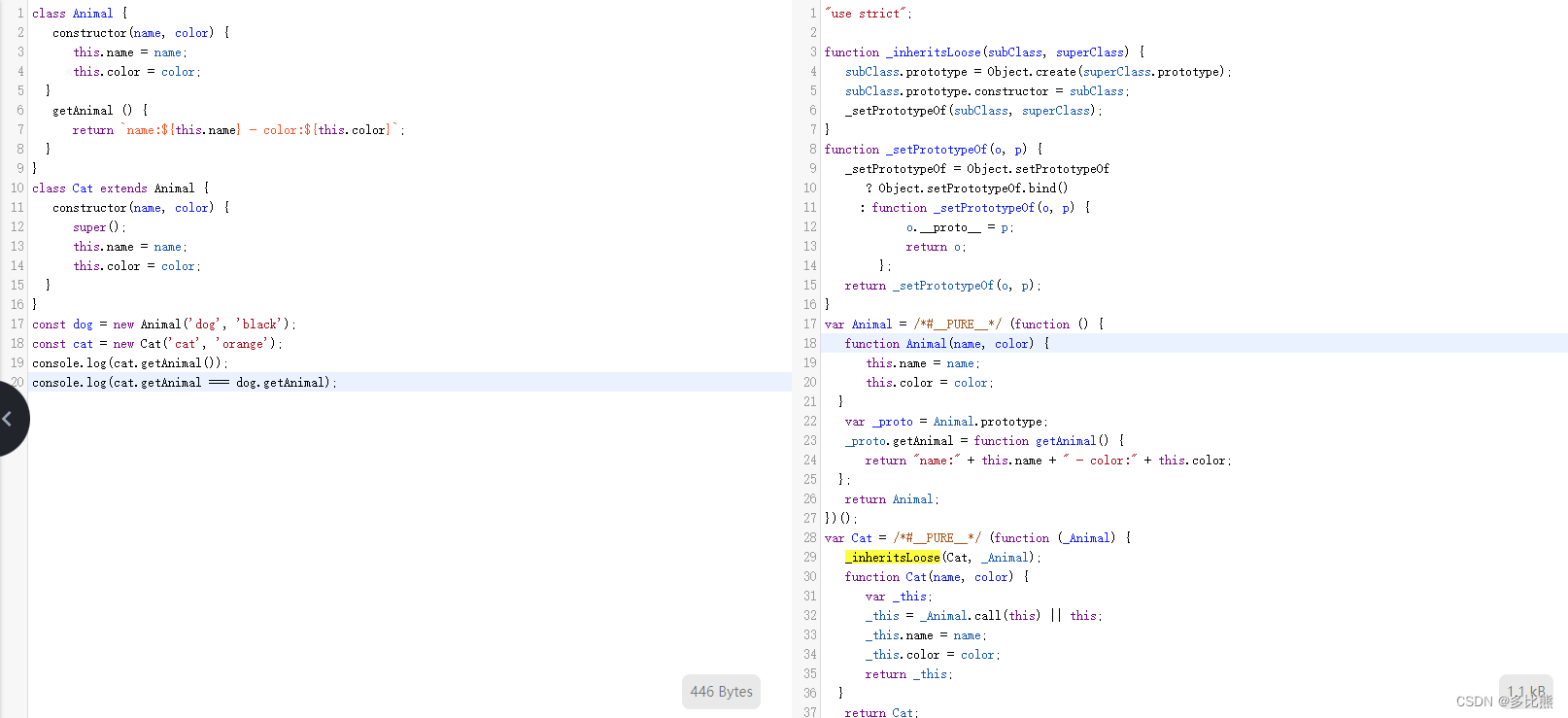JavaScript class和继承的原理
(对于不屈不挠的人来说,没有失败这回事。——俾斯麦)

class
相关链接
MDN链接
有关类的详细描述
关于构造函数,原型和原型链的说明
类的概述
类是用于创建对象的模板。他们用代码封装数据以处理该数据。JS 中的类建立在原型上,但也具有某些语法和语义未与 ES5 类相似语义共享。
实际上,类是“特殊的函数”,就像你能够定义的函数表达式和函数声明一样,类语法有两个组成部分:类表达式和类声明。
JavaScript面向对象编程
在es6之前,面向对象的编程方式都是创建函数和实例化构造函数来达到目的,但这和传统的面向对象编程,比如和c++和,java的差异很大。我们先了解以下函数的面向对象编程方式
函数
创建一个普通函数animal
普通函数是可以当作函数方法来使用,直接执行业务操作后返回
const animal = function (name, color) {
return `动物名称:${name} - 动物毛发颜色:${color}`
};
console.log(animal('刺猬', '褐色'));
创建一个构造函数Animal
构造函数是一种特殊的函数,类似传统编程的类,主要用来初始化对象,即为对象成员变量赋初始值。它总与 new 一起使用。我们可以把对象中一些公共的属性和方法抽取出来,然后封装到这个函数里面。
使用构造函数需要注意以下两点
- 构造函数和传统类的意义相同,首字母要大写
- 构造函数必须实例化才有意义,也就是new
而new的过程中也做了以下事情
- 在内存中创建一个新的空对象。
- 让 this 指向这个新的对象。
- 执行构造函数里面的代码,给这个新对象添加属性和方法。
- 返回这个新对象(所以构造函数里面不需要 return )。
构造函数的成员属性又分为静态属性和实例化属性。
实例化属性只有实例化对象后才能访问,比如hedgehogData。
静态属性不需要实例化对象就可以访问,比如height。
const Animal = function (name, color) {
this.name = name;
this.color = color;
this.getAnimal = function () {
return `动物名称:${this.name} - 动物毛发颜色:${this.color}`
}
};
const hedgehog = new Animal('刺猬', '褐色');
const hedgehogData = hedgehog.getAnimal();
console.log(hedgehogData);
Animal.height = 50;
console.log(Animal.height);
扩展构造函数
如果后续要扩展构造函数,目前我们已经直到可以继续通过编写this.'方法名’的方式来达到目的。但这样对代码有较高的侵入性,会导致构造函数越来越臃肿,并且会导致无效的内存上涨。
const Animal = function (name, color) {
this.name = name;
this.color = color;
this.getAnimal = function () {
return `动物名称:${this.name} - 动物毛发颜色:${this.color}`
}
};
const hedgehog = new Animal('刺猬', '褐色');
const dog = new Animal('狗', '黑色');
console.log(hedgehog.getAnimal === dog.getAnimal); // false 每个实例化对象都有自己的内存地址
但JavaScript还有原型链和原型这两个特性
关于原型和原型链的说明
我们可以通过在原型上自定义的方式进行扩展,这样就可以把成员属性定义在构造函数内,方法通过原型进行扩展。
const Animal = function (name, color) {
this.name = name;
this.color = color;
};
Animal.prototype.getAnimal = function () {
return `动物名称:${this.name} - 动物毛发颜色:${this.color}`
}
const hedgehog = new Animal('刺猬', '褐色');
const dog = new Animal('狗', '黑色');
console.log(hedgehog.getAnimal === dog.getAnimal); // true 原型上的方法和属性由对象直接继承,也就是可以共享访问,所以为true
继承
函数的继承
通过上文我们了解到,如果还想做函数的继承,那么有以下方式
- 继承原型
- 使用call方法继承
- 使用apply方法继承
其步骤较为繁琐,后期维护复杂,并且和传统的面向对象编程方式不同,违背了面向对象变成的理念。
class类
基于以上问题,es6推出了class类语法糖的新规范,写法和传统面向对象类编程的方式更接近。
class Animal {
constructor(name, color) {
this.name = name;
this.color = color;
}
getAnimal () {
return `动物名称:${this.name} - 动物毛发颜色:${this.color}`;
}
}
const hedgehog = new Animal('刺猬', '褐色');
const dog = new Animal('狗', '黑色');
console.log(hedgehog.getAnimal === dog.getAnimal); // true
class继承 extends
其中用到了super关键字
MDN super解释
class Animal {
constructor(name, color) {
this.name = name;
this.color = color;
}
getAnimal () {
return `动物名称:${this.name} - 动物毛发颜色:${this.color}`;
}
}
class Cat extends Animal {
constructor(name, color) {
super();
this.name = name;
this.color = color;
}
}
const dog = new Animal('狗', '黑色');
const cat = new Cat('猫', '橙色');
console.log(cat.getAnimal()); // 动物名称:猫 - 动物毛发颜色:橙色
console.log(cat.getAnimal === dog.getAnimal); // true
class编译后的结果
babel网站,可以在线编辑
我们将上面的class代码编译成nodejs原生的commonjs规范。

"use strict";
function _inheritsLoose(subClass, superClass) {
subClass.prototype = Object.create(superClass.prototype);
subClass.prototype.constructor = subClass;
_setPrototypeOf(subClass, superClass);
}
function _setPrototypeOf(o, p) {
_setPrototypeOf = Object.setPrototypeOf
? Object.setPrototypeOf.bind()
: function _setPrototypeOf(o, p) {
o.__proto__ = p;
return o;
};
return _setPrototypeOf(o, p);
}
var Animal = /*#__PURE__*/ (function () {
function Animal(name, color) {
this.name = name;
this.color = color;
}
var _proto = Animal.prototype;
_proto.getAnimal = function getAnimal() {
return "name:" + this.name + " - color:" + this.color;
};
return Animal;
})();
var Cat = /*#__PURE__*/ (function (_Animal) {
_inheritsLoose(Cat, _Animal);
function Cat(name, color) {
var _this;
_this = _Animal.call(this) || this;
_this.name = name;
_this.color = color;
return _this;
}
return Cat;
})(Animal);
var dog = new Animal("dog", "black");
var cat = new Cat("cat", "orange");
console.log(cat.getAnimal());
console.log(cat.getAnimal === dog.getAnimal);
可以看出class只是语法糖,其类的初始化实际上就是构造函数,extends其内部也依然是原型的继承。
对比
通过原生函数和class的对比,class语法糖的写法更接近传统面向对象编程的方式,也更比原生函数容易开发,方便后期维护。
如何实现多继承
传统的面向对象编程语言都只是单继承,这是因为在大多数业务场景下通过继承能提高开发效率,提高程序性能,提高代码的复用率。但在业务复杂,项目庞大的情况下,也出现了一些缺陷。
- 父子类之间的耦合度过高,父类的改变直接影响到子类。
- 子类的灵活性降低,父类中有些子类不需要或和子类冲突的属性或方法
- 当父类的属性或方法改变时,子类也需要更改,严重时,还需要重构子类
- …
当然,有些业务场景下也确实需要多继承,但class是不支持多继承的,extends后只能编写一个父类。
但我们可以通过原生原型的方式来达到多继承的目的。
function more_father () {
this.f_name = "父亲";
this.f_age = 55;
this.f_address = "北京朝阳"
};
more_father.prototype.f_method = function () {
return this.f_name + this.f_age + this.f_address;
};
function more_mother () {
this.m_name = "母亲";
this.m_age = 53;
this.m_address = "北京朝阳";
};
more_mother.prototype.m_method = function () {
return this.m_name + this.m_age + this.m_address;
};
function more_son () {
this.s_name = "孩子";
this.s_age = 22;
this.s_address = "北京朝阳"
};
more_son.prototype.s_method = function () {
return this.s_name + this.s_age + this.s_address;
};
more_son.prototype.f_pro = new more_father();
more_son.prototype.m_pro = new more_mother();
const _mores = new more_son();
console.log(_mores.f_pro.f_method());
